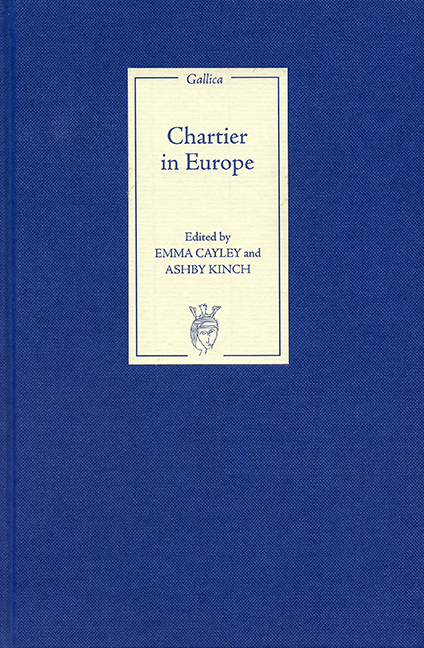Book contents
- Frontmatter
- Contents
- Foreword
- List of Contributors
- Acknowledgements
- List of Abbreviations
- Introduction
- Part I Authorising Chartier
- 1 Boethius as Model for Rewriting Sources in Alain Chartier's Livre de l'Esperance
- 2 ‘Vox Dei, vox poetae’: The Bible in the Quadrilogue invectif
- 3 ‘Car rompre vault pis que ployer’: Proverbial Pleasure in La Belle Dame sans mercy
- 4 Alain Chartier's Livre des Quatre Dames and the Mechanics of Allegory
- Part II Transmitting Chartier
- Part III Translating Chartier
- Bibliography
- Index
- Miscellaneous Endmatter
4 - Alain Chartier's Livre des Quatre Dames and the Mechanics of Allegory
from Part I - Authorising Chartier
Published online by Cambridge University Press: 24 October 2017
- Frontmatter
- Contents
- Foreword
- List of Contributors
- Acknowledgements
- List of Abbreviations
- Introduction
- Part I Authorising Chartier
- 1 Boethius as Model for Rewriting Sources in Alain Chartier's Livre de l'Esperance
- 2 ‘Vox Dei, vox poetae’: The Bible in the Quadrilogue invectif
- 3 ‘Car rompre vault pis que ployer’: Proverbial Pleasure in La Belle Dame sans mercy
- 4 Alain Chartier's Livre des Quatre Dames and the Mechanics of Allegory
- Part II Transmitting Chartier
- Part III Translating Chartier
- Bibliography
- Index
- Miscellaneous Endmatter
Summary
Alain Chartier composed his Livre des Quatre Dames, the longest of his four love debates, sometime between 1415 and 1418. Having spent a decade as notary and secretary to the dauphin Charles (destined to become King Charles VII with some help from Joan of Arc), Chartier had a first-hand vantage point to observe the turbulent political life of the French court in the early decades of the fifteenth century: from the civil war between the Bourguignon and Armagnac factions to the disastrous defeat of the French at the Battle of Agincourt at the hands of the English in 1415. That rout and the subsequent Treaty of Troyes (1422), which named the English king Henry V as successor to Charles VI of France at the expense of his son Charles, marked the nadir of the Hundred Years’ War for the French.
Agincourt is thus among the most dramatic events in French history from the time when the LQD was written. One might wonder whether if there can be any rational connection between such a calamity of the real world and the apparently inconsequential stuff of love debate, which was among the highly codified courtly genres Chartier had inherited from Guillaume de Machaut, Jean Froissart and Christine de Pizan. We should remember, however, that Machaut had introduced an element of realism into the narrative frame surrounding the conundrums of love his characters debate. In his Jugement dou roy de Navarre, he uses the outbreak of the Black Death in 1348 as the device that moves his narrator out into the world and on to his encounter with the other characters. Christine de Pizan adopted the same practice and used increasingly concrete and realistic detail to anchor her love debates in contemporary society. With that facet of the genre in mind, it is perhaps less unexpected that Chartier makes use of the battle of Agincourt as a poignant, pertinent, and compelling framework for the four unhappy tales he develops in the LQD. The ladies of the title refer explicitly in their long speeches to the defeat of the French royal house by the English, and all of their woes stem from that loss.
- Type
- Chapter
- Information
- Chartier in Europe , pp. 61 - 72Publisher: Boydell & BrewerPrint publication year: 2008



